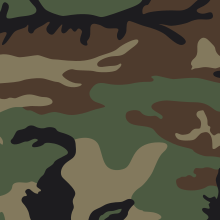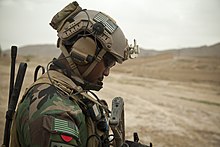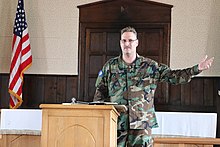| U.S. Woodland | |
|---|---|
 Digitized swatch of the U.S. Woodland pattern Digitized swatch of the U.S. Woodland pattern | |
| Type | Military camouflage pattern |
| Place of origin | United States |
| Service history | |
| In service |
|
| Used by | See Users (for other non-U.S. users) |
| Wars | Invasion of Grenada United States invasion of Panama Lebanese Civil War Somali Civil War Colombian conflict Yugoslav Wars Operation Uphold Democracy War in Afghanistan Iraq War 2006 Lebanon War 2008 Cambodian-Thai stand-off Russo-Georgian War Libyan civil war (2011) Syrian Civil War Russo-Ukrainian War |
| Production history | |
| Produced | 1981–present |
The U.S. Woodland is a camouflage pattern that was used as the default camouflage pattern issued to the United States Armed Forces from 1981, with the issue of the Battle Dress Uniform, until its replacement in the mid to late 2000s. It is a four color, high contrast disruptive pattern with irregular markings in green, brown, sand and black. It is also known unofficially by its colloquial moniker of "M81" after the Battle Dress Uniform it was first used on, though this term was not officially used by the U.S. military.
Although completely phased out of frontline use in the U.S. Armed Forces, U.S. Woodland is still used on some limited level by some branches such as MOPP suits, equipment and vests left over while some modernized uniforms (either BDU or commercial) were worn specifically by special forces such as USMC Forces Special Operations Command and United States Navy SEALs.
Development and history
The woodland pattern is nearly identical to the brown-dominant version of the ERDL pattern, only differing in that it is enlarged by 60 percent. The enlargement was made in order to extend the effectiveness of the camouflage pattern to as close to 350 meters as possible
These changes reflected a shift in the tactical focus of the United States military from fighting an extremely close-range war such as the one in South Vietnam to a longer-range one such as on the fields of Europe.
Near InfraRed compliance
Many old M81 Woodland BDUs are made with Nyco. It is not labeled as NIR compliant however testing done on the material and dyes used in the creation process found it to be effective in camouflaging under InfraRed light.
Coloring
The US Woodland pattern was printed slightly darker than ERDL for two key reasons. First, the chosen colors complemented the pattern sizing, creating a monotone appearance at greater distances and enhancing the effectiveness of the pattern. Second, there was a strategic consideration for large-scale production, where fabrics tend to be lighter than intended due to the production process. By starting with slightly darker colors, the eventual fading of the fabric through use, and washing would result in colors moving closer to the desired target, thereby prolonging the garment's useful life.
Usage

U.S. Army
In the U.S. Army, the woodland-patterned Battle Dress Uniform was replaced by the digital Universal Camouflage Pattern (UCP) found on the Army Combat Uniform, introduced in 2004. UCP itself was replaced by the Operational Camouflage Pattern (OCP) in 2019. The pattern is still used on MOPP suits and some older models of body armor yet to be retired, such as PASGT vests and Interceptor Body Armor.
U.S. Navy
The U.S. Navy no longer uses the Woodland pattern. Most of the Navy has transitioned to the Navy Working Uniform, which uses digital patterns in either a woodland colorway (NWU Type III) or, for some deployed tactical units only, a desert version (Type II).
U.S. Marines

The Woodland Pattern BDU was phased out by the Marine Corps with the introduction of the digital MARPAT Marine Corps Combat Utility Uniform in 2002, although it was reintroduced for the United States Marine Corps Forces Special Operations Command in 2011 and was also worn by MARSOC forces in the War in Afghanistan.
U.S. Air Force
The Air Force phased out the woodland pattern battle dress uniform in 2011 when they went to the Airman Battle Uniform (ABU) which used a pixelated version of the tiger stripe pattern. It was in turn replaced by the Army's OCP by 2021. The Civil Air Patrol, the U.S. Air Force's civilian auxiliary, also used woodland patterned BDUs until being discontinued 15 June 2021.
State defense forces

Several state defense forces use the Woodland Pattern on their BDUs. Members of the Virginia Defense Force wear a Woodland version of the Army Combat Uniform (ACU).
Law enforcement
The pattern also sees use among police departments, such as the Rhode Island State Police.
Users
This section has multiple issues. Please help improve it or discuss these issues on the talk page. (Learn how and when to remove these messages)
|

 Afghanistan: Taliban used copies and US made uniforms circa 1996 to 2001 before the invasion of Afghanistan. Uniform copies and US uniforms used by Taliban during insurgency period. After 2021 takeover woodlands continued to use by Islamic National Army.
Afghanistan: Taliban used copies and US made uniforms circa 1996 to 2001 before the invasion of Afghanistan. Uniform copies and US uniforms used by Taliban during insurgency period. After 2021 takeover woodlands continued to use by Islamic National Army. Argentina: Clones made for Argentine military.
Argentina: Clones made for Argentine military. Armenia: Adopted an Armenian-made Woodland pattern.
Armenia: Adopted an Armenian-made Woodland pattern. Azerbaijan: used by State Border Service of Azerbaijan
Azerbaijan: used by State Border Service of Azerbaijan Bangladesh: Used Woodland uniforms with bright yellow patterns.
Bangladesh: Used Woodland uniforms with bright yellow patterns. Bhutan
Bhutan Bolivia
Bolivia Bosnia and Herzegovina
Bosnia and Herzegovina
 Republika Srpska: Used by the RS' Special Anti-Terrorist Unit.
Republika Srpska: Used by the RS' Special Anti-Terrorist Unit.
 Cambodia: Used Cambodian-made Woodland uniforms.
Cambodia: Used Cambodian-made Woodland uniforms. Chad
Chad Chile
Chile Colombia
Colombia
 Congo-Brazzaville
Congo-Brazzaville Congo-Kinshasa
Congo-Kinshasa Côte d'Ivoire
Côte d'Ivoire Croatia
Croatia Cyprus: Used by Cypriot special forces.
Cyprus: Used by Cypriot special forces. Egypt
Egypt El Salvador
El Salvador Estonia
Estonia Fiji: Woodland camo used by some Fijian military units.
Fiji: Woodland camo used by some Fijian military units. Gambia
Gambia Germany: Used by Kommando Spezialkräfte Marine.
Germany: Used by Kommando Spezialkräfte Marine. Greece: Used by Underwater Demolition Command.
Greece: Used by Underwater Demolition Command. Guatemala
Guatemala Haiti: Known to be used by the Haitian National Police.
Haiti: Known to be used by the Haitian National Police. Honduras
Honduras Hong Kong – Used by the Hong Kong Police tactical unit (SDU)
Hong Kong – Used by the Hong Kong Police tactical unit (SDU) Israel: Used by Israeli military in unofficial capacity.
Israel: Used by Israeli military in unofficial capacity. Kyrgyzstan: Asian-made Woodland patterns used in the Kyrgyz military.
Kyrgyzstan: Asian-made Woodland patterns used in the Kyrgyz military. Kuwait – Used by the Kuwait National Guard.
Kuwait – Used by the Kuwait National Guard. Lithuania
Lithuania Luxembourg
Luxembourg Malaysia: Clones used by PASKAL commandos.
Malaysia: Clones used by PASKAL commandos. Mexico
Mexico Moldova – Worn by Army of the Republic of Moldova.
Moldova – Worn by Army of the Republic of Moldova. Montenegro: Used by the Montenegrin Special Anti-Terrorist Unit.
Montenegro: Used by the Montenegrin Special Anti-Terrorist Unit. North Korea: Reported to be used by North Korean soldiers stationed in the DMZ from 2010.
North Korea: Reported to be used by North Korean soldiers stationed in the DMZ from 2010. Philippines: Woodland uniforms and gear is commonly used but also universally superseded by their locally produced DPM patterns.
Philippines: Woodland uniforms and gear is commonly used but also universally superseded by their locally produced DPM patterns. Russia: Russia uses near-copies (Komplekt kamuflirovannogo obmundirovannogo and Лес or Les ) and true copies (NATO) worn by MVD Agencies such as the Internal Troops and Spetsnaz GRU units.
Russia: Russia uses near-copies (Komplekt kamuflirovannogo obmundirovannogo and Лес or Les ) and true copies (NATO) worn by MVD Agencies such as the Internal Troops and Spetsnaz GRU units. Saint Kitts and Nevis: Used by Saint Kitts and Nevis Defence Force
Saint Kitts and Nevis: Used by Saint Kitts and Nevis Defence Force Saudi Arabia: Used by the Royal Saudi Air Force.
Saudi Arabia: Used by the Royal Saudi Air Force. Somalia
Somalia South Korea: Initially in the early to mid-1980s several local variations were produced in limited amounts and used by certain units in the ROKA and the ROKMC. In 1990 the Republic of Korea Armed Forces introduced a locally produced version based on US woodland (Tonghab Korean: 통합) across all branches, which was the standard issue pattern for uniforms, vests, webbing and helmet covers until 2010 when it began to be replaced by digital patterns Granite B for ROKA and ROKN, digital "tiger stripe" style camouflage pattern, known as 물결무늬 (Wave pattern) - aka WAVEPAT - or 해병 디지털 (Marine digital) for ROKMC and Doksa (독사 or "venomous snake") for ROK-SWC due to reports of North Korea issuing copies of Woodland, however the woodland pattern still continues to see limited use.
South Korea: Initially in the early to mid-1980s several local variations were produced in limited amounts and used by certain units in the ROKA and the ROKMC. In 1990 the Republic of Korea Armed Forces introduced a locally produced version based on US woodland (Tonghab Korean: 통합) across all branches, which was the standard issue pattern for uniforms, vests, webbing and helmet covers until 2010 when it began to be replaced by digital patterns Granite B for ROKA and ROKN, digital "tiger stripe" style camouflage pattern, known as 물결무늬 (Wave pattern) - aka WAVEPAT - or 해병 디지털 (Marine digital) for ROKMC and Doksa (독사 or "venomous snake") for ROK-SWC due to reports of North Korea issuing copies of Woodland, however the woodland pattern still continues to see limited use. Sri Lanka
Sri Lanka Tonga
Tonga Turkey
Turkey Ukraine: Blue Woodland camos used by MVS units. State Border Guard personnel use green woodland clones.
Ukraine: Blue Woodland camos used by MVS units. State Border Guard personnel use green woodland clones. United States: Still used by MARSOC, Marine Raiders and Navy SEALs. At the state-level, several state defense forces use it.
United States: Still used by MARSOC, Marine Raiders and Navy SEALs. At the state-level, several state defense forces use it. Vietnam
Vietnam
Former users
 Islamic Republic of Afghanistan: Formerly used by Afghan National Army and ANA Commandos as standard issue uniforms both locally produced and sourcing US surplus uniforms and foreign clones before switching to Spec4ce Camouflage
Islamic Republic of Afghanistan: Formerly used by Afghan National Army and ANA Commandos as standard issue uniforms both locally produced and sourcing US surplus uniforms and foreign clones before switching to Spec4ce Camouflage Australia: Formerly used by OPFOR in training during the 1990s and 2000s.
Australia: Formerly used by OPFOR in training during the 1990s and 2000s. Azerbaijan: Obtained Turkish-made Woodland uniforms and used from around 2000–12.
Azerbaijan: Obtained Turkish-made Woodland uniforms and used from around 2000–12. Colombia: Formerly used by the National Army of Colombia, used until 1991 and replaced in 2006
Colombia: Formerly used by the National Army of Colombia, used until 1991 and replaced in 2006 Canada: Formerly used by the Canadian Forces as the pattern of helmet covers for the M1 Helmet (both regular and paratrooper variants), the PASGT Helmet and the Spectra Helmet otherwise known as the 'Barrday Helmet'. The Woodland pattern had originally entered service around the same time as the US and had become the standard issue cover by the late 1980s, replacing the older Mitchell Pattern covers. The cover pattern was fully phased out and replaced by CADPAT by the mid-2000s. Helmet covers as well as uniforms (like former US BDUs) and webbing equipment are still seen in Woodland pattern for OPFOR training.
Canada: Formerly used by the Canadian Forces as the pattern of helmet covers for the M1 Helmet (both regular and paratrooper variants), the PASGT Helmet and the Spectra Helmet otherwise known as the 'Barrday Helmet'. The Woodland pattern had originally entered service around the same time as the US and had become the standard issue cover by the late 1980s, replacing the older Mitchell Pattern covers. The cover pattern was fully phased out and replaced by CADPAT by the mid-2000s. Helmet covers as well as uniforms (like former US BDUs) and webbing equipment are still seen in Woodland pattern for OPFOR training. Georgia: Former standard issue camouflage pattern of the Georgian Armed Forces, replaced in 2007.
Georgia: Former standard issue camouflage pattern of the Georgian Armed Forces, replaced in 2007. Iraq: Formerly used by reformed post-2003 Iraqi military.
Iraq: Formerly used by reformed post-2003 Iraqi military.
 Latvia – Worn by the Latvian Land Forces from 1992 to 2007 when the M07 LATPAT camo was issued.
Latvia – Worn by the Latvian Land Forces from 1992 to 2007 when the M07 LATPAT camo was issued. Lebanon - Replaced in 2017 by the Operational Camouflage Pattern
Lebanon - Replaced in 2017 by the Operational Camouflage Pattern Netherlands: Worn by the Royal Netherlands Marine Corps, most of the Woodland camos being replaced by Dutch-made fractal camo.
Netherlands: Worn by the Royal Netherlands Marine Corps, most of the Woodland camos being replaced by Dutch-made fractal camo. Nigeria: Used by the Nigerian military until they were replaced by the M14 pattern.
Nigeria: Used by the Nigerian military until they were replaced by the M14 pattern. Ba'athist Syria: Copies made for the Syrian military.
Ba'athist Syria: Copies made for the Syrian military. United States: Former standard issue camouflage uniform pattern for all branches of the U.S. Armed Forces.
United States: Former standard issue camouflage uniform pattern for all branches of the U.S. Armed Forces.
See also
References
- "Gaddafi's Army". Reuters. April 27, 2011.
- Hardyman, Christine O., ed. (1988). "Chapter 7: Support Services". Department of the Army Historical Summary FY 1981. United States Army Center of Military History.
- "Woodland Is Back!". Soldier Systems. November 17, 2014. Archived from the original on 2014-11-20.
- Ramsley, Alvin; Bushnell, William (January 1981). DTIC ADA096884: Development of the U.S. Woodland Battle Dress Uniform (Report). Defense Technical Information Center. pp. 6–7. Retrieved 2023-12-05.
- Vasquez, Justina (August 22, 2018). "Making a 21st-century US military uniform every branch can wear". Stars and Stripes. Archived from the original on 2018-08-22.
- ^ "M81 Woodland: From 80s to eternity?". Millennial Arms LLC. Retrieved 2024-04-29.
- "NIR Compliant Gear: The Basics". Millennial Arms LLC. Retrieved 2024-04-29.
- "MARSOC adopts woodland Crye Precision uniform". Military.com. 22 August 2011.
- Losey, Stephen (May 14, 2018). "The long-awaited OCP uniform is on its way to the Air Force — and here's when you could get it". Air Force Times. Retrieved May 15, 2018.
- "CAP Regulation 39-1 - Civil Air Patrol Uniform Regulation" (PDF). National Headquarters Civil Air Patrol. March 5, 2020. Retrieved December 23, 2020.
- "Questions & Answers about the Tennessee State Guard". Third Regiment of the Tennessee State Guard Official Website. Retrieved 22 February 2017.
- "VDF Regulation 670-1" (PDF). Virginia Defense Force. Retrieved 18 December 2021.
- "Frequently Asked Questions". Ohio Military Reserve. Retrieved 22 February 2017.
- "Uniform Gallery". Rhode Island State Police. Archived from the original on 8 November 2016. Retrieved 12 January 2022.
- Larson (2021), p. 126.
- Larson (2021), p. 194.
- Larson (2021), p. 203.
- Larson (2021), p. 205.
- "Special Anti-terrorist Unit of Republic of Srpska". Specijalne-jedinice.com. Archived from the original on March 24, 2018.
- Larson (2021), pp. 209.
- ^ "U.S. Woodland pattern camouflage". Kamouflage.net. Archived from the original on 3 March 2014. Retrieved 12 January 2022.
- "Croatian Woodland shirt". CamoUniforms.net.
- "Croatian Woodland Shirt 02". CamoUniforms.net.
- Larson (2021), p. 219.
- "Estonia". Camopedia.
- Larson (2021), p. 477.
- Larson (2021), p. 390.
- "Uphold Democracy 1994: WWII weapons encountered". WWII After WWII. 9 June 2015.
- Larson (2021), p. 255.
- Larson (2021), p. 268.
- "Lithuanian Woodland jacket". CamoUniforms.net.
- "Standardized U.S.-Led Coalition Forces Uniform" (PDF). Defense Technical Information Center. Archived (PDF) from the original on 27 March 2020. Retrieved 12 January 2022.
- "Luxembourg gets its own camo pattern!". IACMC Militaria Forum. June 5, 2011.
- Larson (2021), p. 275.
- "Special Anti-terrorist Unit of the Republic of Montenegro". Specijalne-jedinice.com.
- Zwirko, Colin (22 November 2018). "North Korean soldiers at Joint Security Area sporting new uniforms, photos reveal". NK News. Archived from the original on 2020-03-04.
- Desmond, Dennis (1997). Camouflage Uniforms of the Soviet Union and Russia: 1937-to the Present. Schiffer Publishing, Ltd. ISBN 978-0764304620.
- Galeotti (2015), p. 39.
- "Camouflage Patterns of the South Korean Armed Forces". Camopedia.org. Archived from the original on 2024-05-09. Retrieved 2024-05-09.
- ^ Larson (2021), p. 458.
- "VDF chaplains provide support at Fort Pickett chapel". Virginia National Guard.
- "Tìm hiểu về quân phục ngụy trang của quân đội Việt Nam (phần 2)". Tin tức Việt Nam - Cập nhật tin tức trong nước hôm nay (in Vietnamese). 2018-03-04. Retrieved 2019-04-16.
- "Afghanistan". Camopedia.org. Retrieved 23 July 2023.
- Larson (2021), p. 199.
- ^ "Canadian Forces Woodland". Canadian Military Police Virtual Museum. Archived from the original on 2017-11-13. Retrieved 2022-04-13.
- "Iraqi Woodland Camo". Middle East Militaria.
- "New Iraqi Woodland Camo Uniform". Middle East Militaria.
- "Kurdish 2 Pocket Woodland Camo Uniforms". Middle East Militaria. Retrieved 8 January 2024.
- "Kurdistan". Camopedia.org. Retrieved 8 January 2024.
- "Latvian M07 LatPat Camouflage". 29 April 2020.
- "Latvian US M81 Woodland Camouflage". 4 May 2020.
- "Dutch Army Adopts Netherlands Fractal Pattern Camouflage". Soldier Systems. 27 October 2014.
- "Nigerian Armed Forces ~ M14 Arid Pattern". 29 December 2020.
- "From Russia with Love, Syria's AK-74Ms". Bellingcat. 19 February 2015. Archived from the original on December 4, 2023.
Bibliography
- Galeotti, Mark (2015). Spetsnaz: Russia's Special Forces. Osprey Publishing. ISBN 978-1472807229.
- Larson, Eric H. (2021). Camouflage: International Ground Force Patterns, 1946–2017. Barnsley: Pen & Sword. ISBN 9781526739537.
